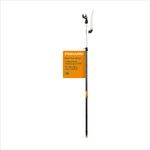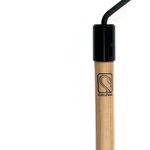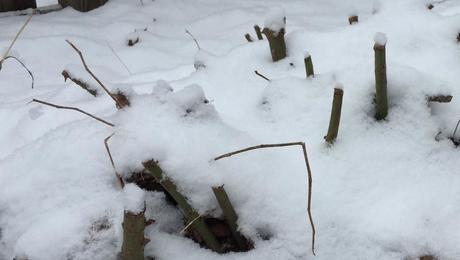
You hear the term “sucker” a lot when it comes to roses but many people are not really sure what it actually means. So with the spring bloom coming on I thought I’d take a moment to talk about them because they tend to bloom only in the spring and that is when it’s easiest to identify them.
First, what is it?
Many roses are budded onto an understock or rootstock. (The other term you hear is grafted). This understock is not actually the rose variety you purchased. In the United States, the understock is almost always Dr. Huey and in some instances Rosa multiflora.
The rose variety you purchased is budded onto this understock and that is how a budded rose plant is made. The spot where the rose you purchased was budded onto the understock is called a “bud union.” This is the “knot” just above the roots where the canes grow out of. Everything below the bud union is the understock, and everything above it is the rose variety you purchased.
The way it is supposed to work is that the understock stays below the bud union in the ground and forms roots, and the rose variety you purchased stays above the bud union and produces the blooms you fell in love with.
But Murphy’s Law even applies to roses.
Occasionally the understock will produce a cane from beneath the bud union that pops up out of the ground and grows like mad. And because it is produced from below the bud union, it “sucks” the nutrients up before they can get to the rose variety you purchased. Hence the term sucker. Eventually these suckers will kill the rose variety you purchased, leaving you with nothing but understock.
But the first spring flowering is the perfect time to identify them before they can take over. Dr. Huey is a small dark red bloom (see photo), and R. multiflora produces sprays of small white, single blooms. Also R. multiflora is generally thornless, with lighter green foliage. The canes and foliage of Dr. Huey are generally harder to tell apart from the rose variety you purchased.
If you have a sucker, simply follow it all the way back to where it is growing from the understock. You may even have to dig down a bit. Cut it off right at that point of contact. If you cut above it, then it will simply sprout faster and even produce more canes—or suckers.
I hope this helps you not only identify suckers but also how to get rid of them. And by the way, if you have your own root roses, don’t worry about it. They cannot produce a sucker because there is no understock. And that is another reason why I prefer them.
Happy Roseing,
Paul Zimmerman
Fine Gardening Recommended Products

Fiskars 7.9-12ft Extendable 2-in-1 Pole Tree Trimmer & Pruner with Rotating Head and Precision-Ground Steel Saw Blade
Fine Gardening receives a commission for items purchased through links on this site, including Amazon Associates and other affiliate advertising programs.

SHOWA Atlas 370B Nitrile Palm Coating Gloves, Black, Medium (Pack of 12 Pairs)
Fine Gardening receives a commission for items purchased through links on this site, including Amazon Associates and other affiliate advertising programs.

CobraHead® Long Handle Weeder & Cultivator Garden Tool
Fine Gardening receives a commission for items purchased through links on this site, including Amazon Associates and other affiliate advertising programs.


















Comments
Congratulations! This is concise and easily understandable. Thanks for the information.
Thank you!
Own Root Roses solve this problem. Heirloom Roses have a great selection.
are this sucker? anyone help?
I may be an idiot, but I put 3 roses in the ground toward the end of last season as they were 1/2 off. Idiot because I'm not experienced in caring for roses. So...I wait until I see the flowers that are not the right ones before cutting the cane off, rather than willy-nilly cutting new growth now? I have a cane coming from pretty low, on a plant already weakened by black spot and a frost that burned off the new foliage a few weeks ago and I'm worried my plant will be further stressed and die, especially with my limited knowledge.
Log in or create an account to post a comment.
Sign up Log in